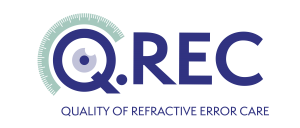A wide range of information can be obtained from the Q.REC study. Some examples can be found in the table below. The Q.REC outcomes should be able to identify:
- Areas of refractive error services or clinical practice measures that might need improvement and to support evidence-based interventions
- Evidence for advocacy, awareness creation for potential policy changes
- Gaps in information that would benefit from further research
The information obtained from the Q.REC study can be useful for sharing with entities that have authority in implementing evidence-based interventions, such as ministries of health, or national eye health committees.
Key quality issues and indicators
| Key issue in quality of refractive error care | Results indicating the issue needs addressing |
|---|---|
| Refraction | Spherical, cylindrical or axis components have more errors than prism, and written prescriptions highly match the dispensed spectacles |
| Using autorefraction more than subjective refraction | |
| Near subjective refractions are completed more than distance subjective refractions | |
| Some refractive error types are less likely to receive optimal spectacles that other types | |
| Dispensing | Prism errors occur more than other spectacle components |
| Dispensed spectacles that do not match written prescriptions | |
| Patient-centredness | Communication outcomes associated with optimal care |
| A high proportion of emmetropes being recommended and/or dispensed unnecessary spectacles | |
| Gender-equity | Difference in male and female USPs receiving optimal spectacles |
| Difference in male and female USPs with emmetropia being recommended and/or dispensed unnecessary spectacles | |
| Difference in male and female clinicians seen by USPs |
